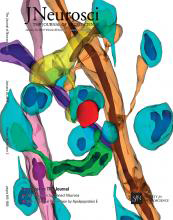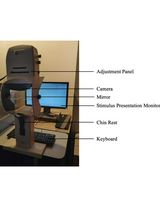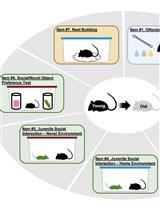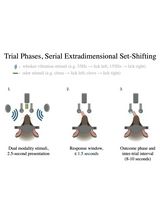- EN - English
- CN - 中文
Cued Rat Gambling Task
线索诱导的大鼠博弈行为模型
发布: 2017年02月05日第7卷第3期 DOI: 10.21769/BioProtoc.2118 浏览次数: 12824
评审: Soyun KimAdler R. DillmanAnonymous reviewer(s)
Abstract
The ability of salient cues to serve as powerful motivators has long been recognized in models of drug addiction, but little has been done to investigate their effects on complex decision making. The Cued rat Gambling Task (CrGT) is an operant behavioural task which pairs salient, audiovisual cues with the delivery of sucrose pellet rewards on complex schedules of reinforcement that involve both sugar pellet ‘wins’ and timeout penalty ‘losses’. The task was designed with the intention of providing insight into the influence of such cues on decision making in a manner that models human gambling.
Keywords: Decision making (决策)Background
Although numerous rodent behavioural paradigms that capture different facets of gambling-like behaviour have recently been developed, the motivational power of cues in biasing individuals towards risky choice has so far received little attention despite the central role played by drug-paired cues in successful laboratory models of chemical dependency. Here, we describe the cued rat Gambling Task (CrGT) - a cued version of the rGT analogue of the Iowa Gambling Task (Zeeb et al., 2009). In these tasks, animals chose between four options associated with different magnitudes and frequencies of reward and punishing time-out periods. As in the Iowa Gambling Task, favoring options associated with smaller per-trial rewards but smaller losses, and avoiding the tempting ‘high-risk, high-reward’ options, maximized gains on the task. Crucially, in the CrGT, salient, audiovisual cues were paired with the delivery of sucrose pellet rewards. These cues increase in complexity with the size of the ‘win’, similar to human gambling scenarios. Recent data indicate that the addition of these reward-concurrent cues drastically increases choice of the maladaptive, risky options, thereby biasing choice against the animals’ best interests.
Materials and Reagents
- Male Long-Evans rats (Charles Rivers Laboratories) weighing 250-275 g upon arrival at the animal facility
Notes: - Initially animals should be gradually food restricted to 85% of free-feeding weight (fed ~14 g of standard rat chow per day).
- Water is available ad libitum in home cages.
- Animals are housed in pairs/trios and maintained in a climate-controlled colony room on a 12 h reverse light cycle (lights off at 8:00 AM). Temperature is kept between 19-23 °C and humidity ranges from 40%-70%.
- Bio-Serv Dustless Precision Pellets, 45 mg, sucrose (Bio-Serv, catalog number: F06233 )
Equipment
- Chambers (Med Associates) (Depicted in Figure 1)
- Extra tall modular test chamber (Med Associates, catalog number: ENV-007-VP )
- Extra tall MDF sound attenuating cubicle (Med Associates, catalog number: ENV-018MD )
- 5 unit curved nose poke wall (Med Associates, catalog number: ENV-115A )
- Stainless steel grid floor (Med Associates, catalog number: ENV-005 )
- Hooded house light (Med Associates, catalog number: ENV-215M )
- Pedestal mount pellet dispenser for rat (Med Associates, catalog number: ENV-203-45 )
- Pellet receptacle (Med Associates, catalog number: ENV-200R2M-6.0 )
- Receptacle light (Med Associates, catalog number: ENV-200RL )
- Head entry detector for rat (Med Associates, catalog number: ENV-254-CB )
- Multiple tone generator (Med Associates, catalog number: ENV-223 )
- Cage speaker (Med Associates, catalog number: ENV-224AM )
- Large tabletop cabinet and power supply (Med Associates, catalog number: SG-6510D )

Figure 1. Testing chamber. ‘A’ right side of chamber, ‘B’ left side.
- Extra tall modular test chamber (Med Associates, catalog number: ENV-007-VP )
- IBM-compatible computer running Med PC software
- CrGT code and training programs (5CSRT and CrGT forced choice) (freely available from Dr. Catharine Winstanley upon request)
- Personal protective equipment (PPE): May include (but is not limited to) scrubs, a laboratory coat, gloves, bouffant cap, ventilation mask, and shoe covers, depending on the requirements of the unit in which the work is taking place
Software
- Med PC software
Procedure
文章信息
版权信息
© 2017 The Authors; exclusive licensee Bio-protocol LLC.
如何引用
Readers should cite both the Bio-protocol article and the original research article where this protocol was used:
- Barrus, M. M. and Winstanley, C. A. (2017). Cued Rat Gambling Task. Bio-protocol 7(3): e2118. DOI: 10.21769/BioProtoc.2118.
-
Barrus, M. M. and Winstanley, C. A. (2016). Dopamine D3 receptors modulate the ability of win-paired cues to increase risky choice in a rat gambling task. J Neurosci 36(3): 785-794.
分类
神经科学 > 行为神经科学 > 认知
您对这篇实验方法有问题吗?
在此处发布您的问题,我们将邀请本文作者来回答。同时,我们会将您的问题发布到Bio-protocol Exchange,以便寻求社区成员的帮助。
提问指南
+ 问题描述
写下详细的问题描述,包括所有有助于他人回答您问题的信息(例如实验过程、条件和相关图像等)。
Share
Bluesky
X
Copy link














